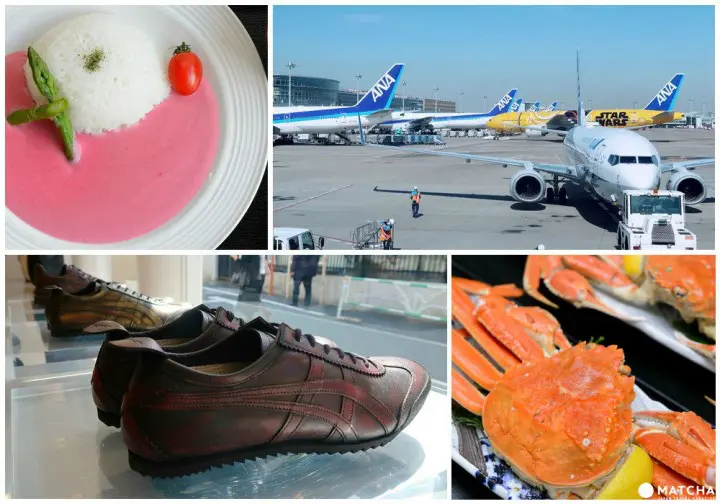ASICS JAPAN COLLECTION - Stride With Japanese Craftsmanship And Technology

The ASICS JAPAN COLLECTION is ASICS's newest footwear series to feature quality Kobe beef cattle leather. Discover how these world-class sneakers are made at the production factory in Japan, utilizing cutting-edge technology at the company's research institute.
ASICS JAPAN COLLECTION – Uncompromisable Quality in Footwear
If you take a look at your belongings, you’ll notice that some were made in Japan. This article will be introducing a Japanese brand that you’re likely familiar with—ASICS—a beloved shoe brand worn by many people.
Even if you’re unfamiliar with the name ASICS, you may know it as the company behind Onitsuka Tiger, a popular sports apparel brand. The running shoes and everyday footwear at ASICS are crafted utilizing various types of technology.

This time, we traveled to SANIN ASICS Industry Corporation (SANIN ASICS Industry)—the brand’s production factory in Tottori Prefecture—and the ASICS Institute of Sports Science—a research institute in Hyogo Prefecture's Kobe City—to cover the new ASICS JAPAN COLLECTION.
During our visit, we were able to catch a glimpse of the Japanese-quality care put into each and every shoe. We explore the production of ASICS shoes, a leading sportswear brand recognized worldwide, and the mindset of employees working at this prominent company.
SANIN ASICS Industry – Where Sneakers are Made to Perfection

SANIN ASICS Industry is the company’s sole domestic factory manufacturing sneakers. The ASICS JAPAN COLLECTION introduced in this article are handmade here.
The shoes are made in several different stages, ultimately joined together at the end to create the finished product. Let’s take a look at the manufacturing process below.
Cutting the Shoe Patterns

The shoe manufacturing process begins with cutting out the leather for each shoe's component using a cutter.

Hard and soft leather have different purposes depending on the shoe's design. Sometimes, real leather is delivered to the factory already damaged from the leather-making process. Due to these circumstances, the leather is cut while each piece is carefully checked in order to avoid using damaged parts.
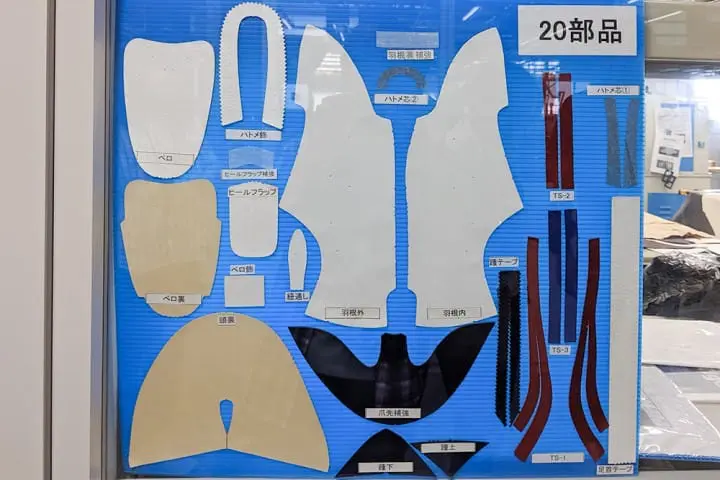
A shoe may sometimes be split into as many as 20 different components. Even within a single model, the cutters can change depending on shoe size. As a result, there are reportedly over 1,000 different types of cutters at the factory.
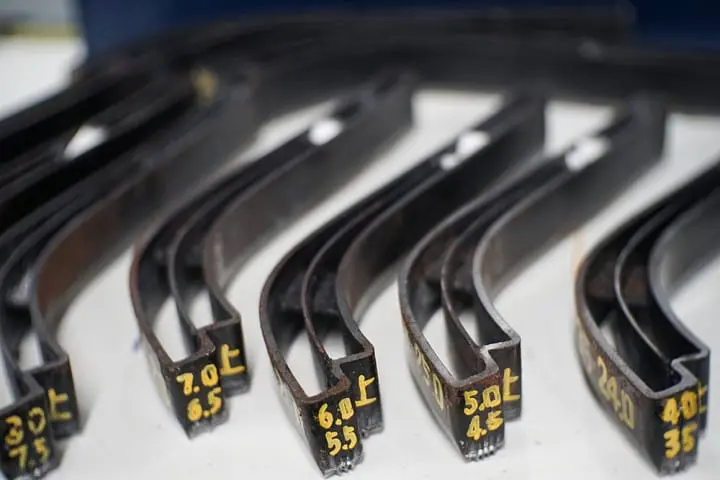
This is the cutter for the ASICS Stripe, the trademark lines on the side of every sneaker. A cutter is also made for every single line.
Parts Are Sewn and Then Glued Together
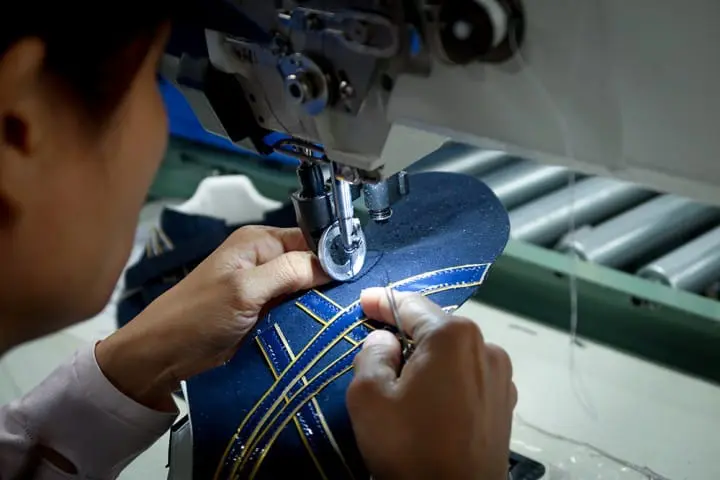
Next, the parts are joined together to create the shoe’s shape. The above photo depicts the sewing machine’s needle running up and down along the edge of the ASICS stripe to combine the parts into one piece.
The skilled craftsmen expertly maneuver the leather by hand, showing their impeccable technique. Lines are smoothly sewn into the fabric regardless of the thick, hard-to-sew material.
A sewing machine needle can easily slip when stitching over uneven parts. Therefore, craftspeople require at least two to three years of training to master this technique.
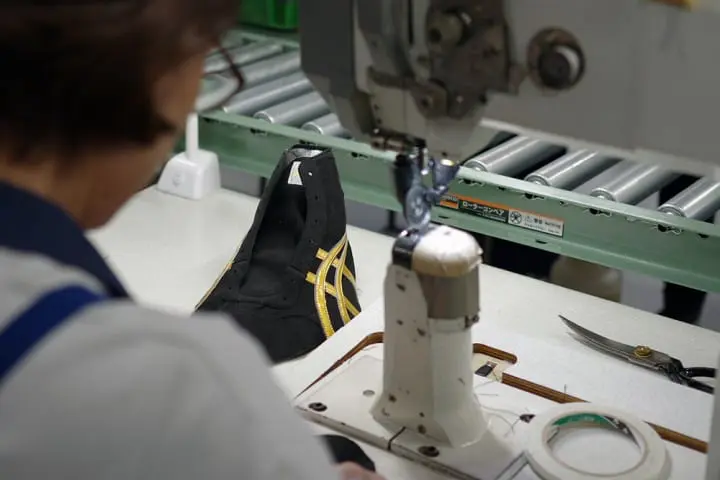
Once the loose parts have been sewn together, the shoe becomes a more recognizable shape. The picture shows the top part of the shoe called the upper. The sole has not been attached yet.

The upper is slipped onto a yellow shoe-shaped piece called the last, which is then joined together with the sole.
If the shoe becomes bent when the upper is placed onto the sole, the footwear will lose its shape and cannot be sold as a product. Even if machines are used in the manufacturing process, it requires the tedious handiwork of a craftsperson to finish the shoe.

Next, the upper gets coated with adhesive. Because some binding agents won't properly stick depending on the type of leather, the cowhides that will come into contact with the adhesive are initially polished.
The levels of polishing are very important. Adhesives are unable to attach well when there isn't enough polish or if it has been polished too much.
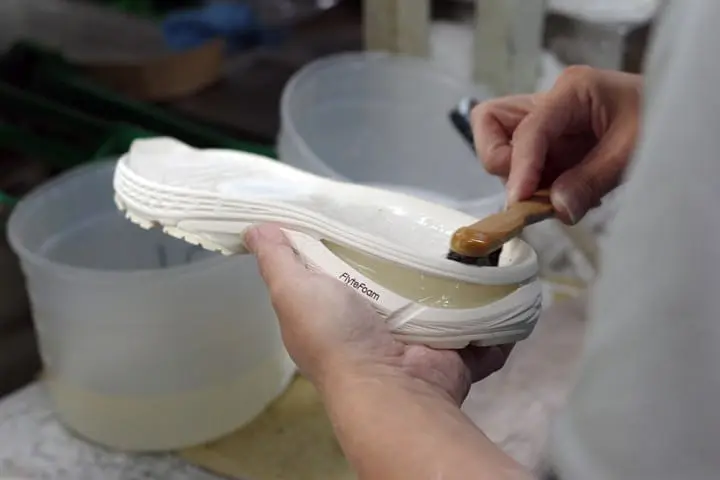
Once the adhesive is added onto the upper, it is also applied in a similar fashion to the sole. The shoe will then be applied with a heat treatment to dry the bonding agent.

Once the adhesive has been uniformly applied all over the shoe, the upper and sole are glued together. This is another process that requires meticulous attention.
When a sole doesn’t fit perfectly into its designated spot, the adhesive will become loose and produce creases in the sole. A craftsperson's skills are necessary to prevent even the slightest gap.
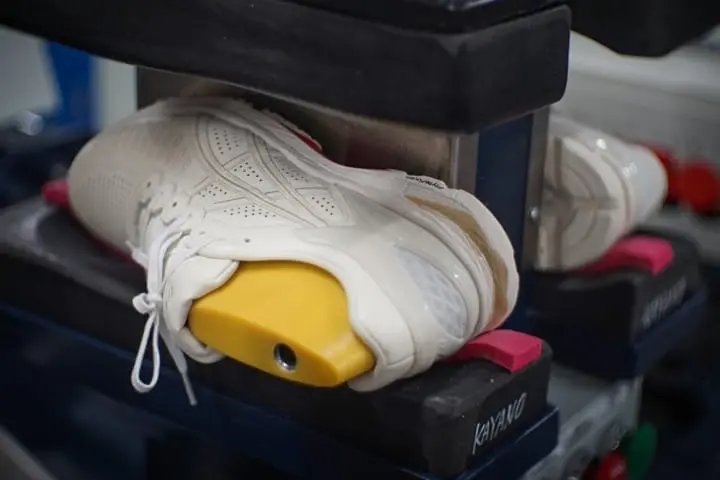
Once the upper and sole have been joined together, the shoe is placed into a machine press to further ensure that the sole will not come off.

Now they're a pair of perfectly-crafted shoes. They will undergo a final inspection and, if they pass, the footwear are complete!
The black sneakers in the front are the GEL-KAYANO 25 SPS while the white ones in the back are the METARUN SPS. These are the latest releases from the ASICS JAPAN COLLECTION, which has a total of seven models.
Made with real leather, these shoes are built to be both durable and high quality.
Born from Care and Craftsmanship

A high level of skill and concentraction is part of the manufacturing of each pair of ASICS. After our factory tour, we interviewed the ASICS’ staff and production director and heard these surprising words: “Inferior products cannot be made during the production.”
Additionally, the Executive Director Mr. Nose continued with this statement:
“Our craftspeople handle the shoemaking production with a sense of pride. They constantly think about making the best product and work with intense care.”
How do they manage to perfect these shoes each time?
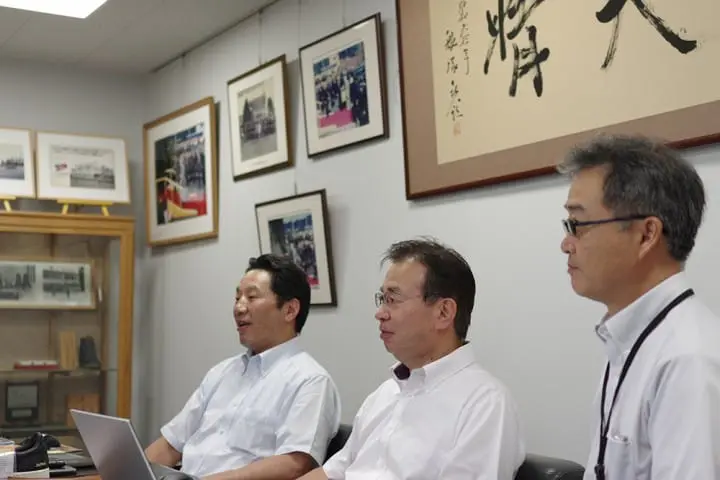
Photo left: Mr. Nose (Executive Director), Middle: Mr. Okada (Director), Right: Mr. Nishitomi (Director)
Mr. Nose continued to explain, “We strive to create products that can precisely fulfill our customers' footwear needs. Whether it be in track-and-field events or basketball games, what type of movements are they making? Once precisely grasping what our customers desire in a shoe, our experienced craftspeople make it a reality.”
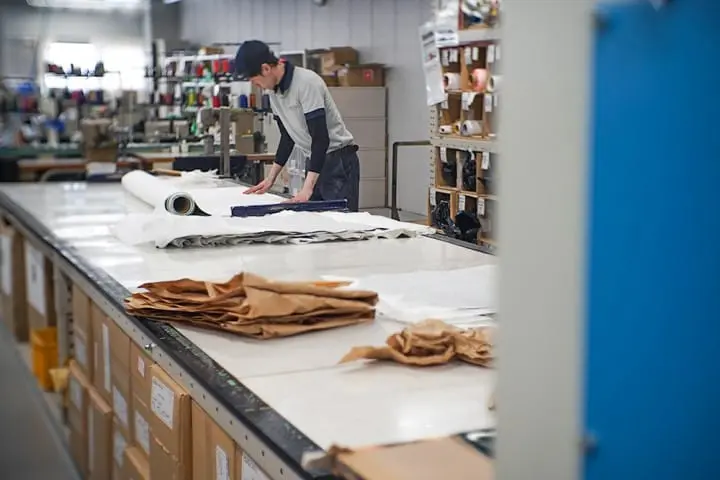
Before visiting, we imagined the factory environment to be full of seated craftsmen, repeating the same work over and over again. However, the craftsmen in the factory learn how to do different parts of the process themselves so that they’re able to do all types of tasks.
Seasoned craftspeople can perform all manufacturing processes by themselves from start to finish, according to Mr. Nose.
This allows them to give suggestions for improvement in other work departments and make it possible to enhance the quality of the products.

Since each craftsperson knows the entire manufacturing process, they properly understand which task should be completed next and how it should be executed to make the process easier.
Not only does this improve the quality of the product, but it also creates teamwork.
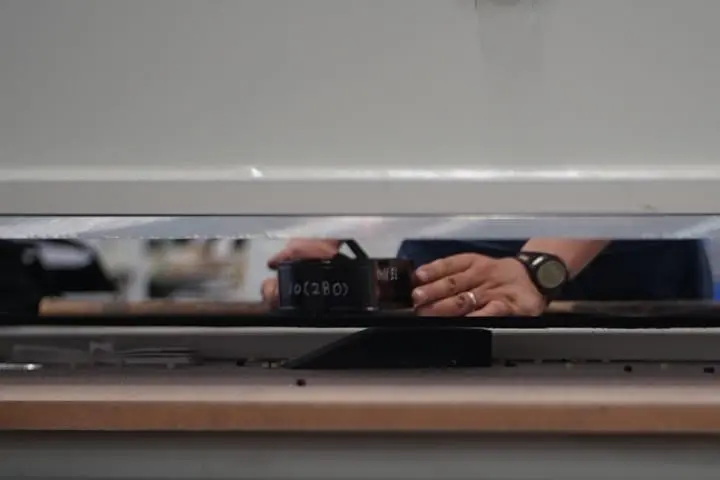
Even when prototype models are made, craftspeople involved in the production work together, monitoring the design and production methods.
Feedback is a large part of the process. The footwear goes through several trial-and-error stages before deciding on the final product and production schedule.
Sometimes, a prototype model will be remade four times, even taking up to four months to complete. However, the amount of time spent is not an issue. The focus is on how much the product quality has improved.
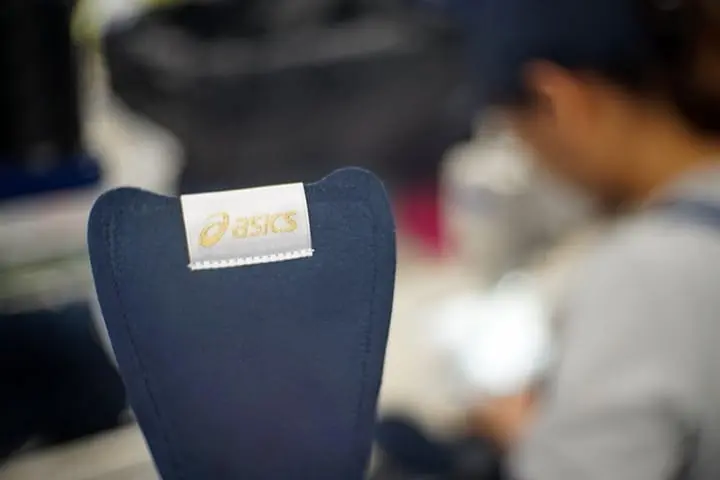
Lastly, we asked everyone what they considered to be the most important factor in shoe production.
Director Okada told us, “When creating products, it's crucial to put our minds together and have the same motives for making the footwear. What type of shoes should we make to satisfy our customers? What we strive for must be the same. This is very important. That’s because the outcome will turn out differently if each person’s resolve is different."
He continued, "A phrase our founder left us is to 'act in perfect harmony.' This ideology continues today.”
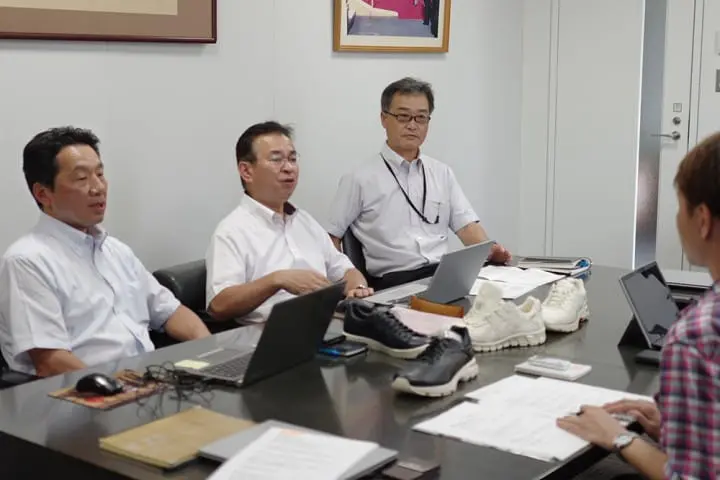
Mr. Nose added, “As you can see from the phrase 'act in perfect harmony,' our founder considered 'creating a product with a shared determination' to be the most important factor when building this factory."
The founder of ASICS also once said, “You must make the people around you happy to be happy yourself.” Manufacturing involves the help of others. I believe that if you want to create something great, then you must work with the people with the same goals and resolve.
"This year, the factory will turn 50 years old. I hope that our founder’s teachings continue to be passed on and practiced,” concluded Mr. Nose.
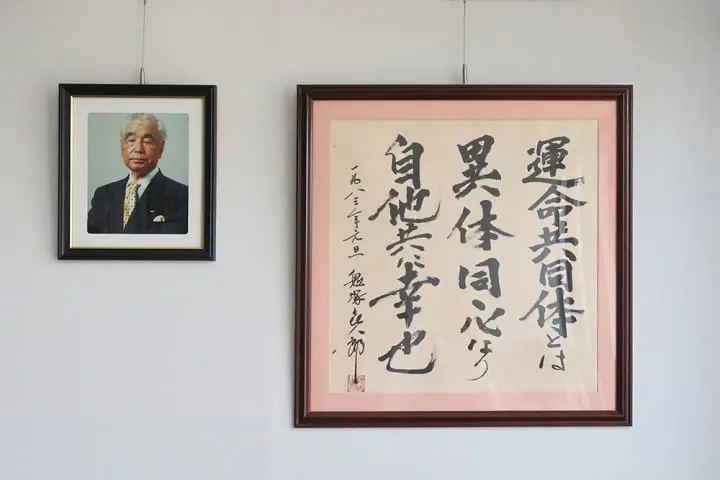
On our way to the entrance, we spotted a photo of Kihachiro Onitsuka, the Japanese footwear's founder, and a handwritten letter with the phrase “act in perfect harmony.” We truly felt that this must be one of the reasons why ASICS is loved all over the world.
ASICS Institute of Sports Science – Expanding Human Potential with Technology

Before shoes are manufactured at SANIN ASICS Industry, thorough research is conducted at the ASICS Institute of Sports Science (ISS). Here, the movement of people and shoes are analyzed to spark innovative developments towards materials used in the brand’s shoes.
If the frontline team is the factory where they put emphasize on the shoe's structure, then ISS is the behind-the-scenes team. At the institute, they use advanced technology to analyze data from research. It takes many repeated trial-and-error experiments before passing the baton to the factory.
ISS is a research institute that handles everything from kinematic analysis in relation to the human body and natural movements and shoe material development. It also is responsible for computer forecasts and inspections on functionality and merchandise quality assurance.

Japan has one of the strongest positions in the technology field in the world. The research institute also makes full use of their technologies such as motion capture—used in animation and film production to analyze human movement—and a simulation system that measures the efficiency of the shoes components and creates an image of the final outline.

Ms. Ishikawa, the person that showed us around ISS, told us, “We always ask ourselves 'for who and what purpose do we create shoes to wear? What can be done to make them better?'”
Even if there's an outstanding product in the current lineup, we question how we can create a product that's "even one percent better."
They continued, “Even when choosing a material for the sole, we repeat studies to determine whether we’re able to make it more resilient and out of a lighter material. A sample shoe is created out of prospective materials which is then reviewed to see whether or not it has truly improved. We continue this multiple times until we find the functionality that we’re seeking.”
Even if it’s just to improve the product's materials, various departments cooperate.
Ms. Ishikawa said, “There’s a department that creates the material, one that researches what shape to make that material, and one that reviews its performance. Teamwork is essential. Everyone comes together as one with the desire to produce great shoes.”

“Everyone comes together to create something great.” This was a phrase we heard several times while we were visiting the institute.
“Everyone” doesn’t only include the people that work at the research institute. Desired functions in a shoe are designated at the ISS before launching the footwear's structure and composite design, prototype models, and functional evaluation. Only then are these products made at the factory. Once this step is complete, the promotion and sales begin.
Ms. Ishikawa commented, “Our teamwork is vital to deliver shoes to our customers filled with love and care.”
There aren't many opportunities to learn about the hard work that people do behind the scenes. After traveling here and seeing the rigorous attention poured into the smallest details of the manufacturing process, we were able to understand why ASICS shoes are appreciated around the world.
Wear ASICS JAPAN COLLECTION to Experience Japanese Craftsmanship
The deliberate, intricate work of Japanese artisans and ASICS innovative technology created the ASICS JAPAN COLLECTION. In this footwear series, seven different models of shoes have been remade using domestic quality leather.

These shoes are made with Kobe cow leather that has been tanned and colored black. The ASICS stripe—the distinguishing feature on existing shoes—paired with the soft, smooth leather, further enhances its charm.
Models are listed below
・GEL-KAYANO 25 SPS
・GEL-KINSEI OG
・GEL-PTG LO
The ivory Himeji leather gets more beautiful the more it is worn. These latest models are skillfully decorated with holes and stripes found on existing shoes and are very soft and flexible.
Models are listed below
・GEL-KAYANO 5 OG
・METARUN SPS
・GEL-PTG MT
・GEL-KAYANO 5 360
In Conclusion
All shoes in the ASICS JAPAN COLLECTION utilize quality technology, like the ASICS GEL™ technology that reduces impact. Footwear from this collection is wonderful to wear not only when you’re running, but also on a day out.
Make your way to an ASICS shop to slip your feet into these extraordinary shoes.
Pictures courtesy of ASICS Corporation
Sponsored by ASICS Corporation














